
|   |

|   |
 e-mail: arshiyasethi@gmail.com For the Meerabai-s of Dance there is No Prescribing, No Proscribing: Dance is India's unfettered soul April 10, 2022 When I set out to write this piece it had a definite but narrow focus. Its focus was prohibiting dance, even certain kind of dance and about rebarbative relationships among dance and patron communities. But within days, the matter spread to a larger issue. I would use a colloquial Hindi phrase 'raita phailana' to describe what happened. An attempt has been made in this column to include all the new developments as well because this column sees itself as one that compels us to apply 'soch' to contemporary issues. It is a long read but a very important one. I hope the reader will realise its import and stay till the end. 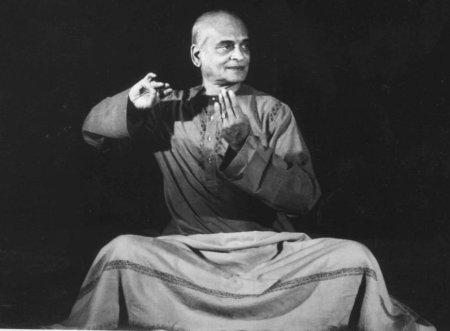 Mohanrao Kallianpurkar I am writing a book on the first Non Gharanedaar, nationally awarded Kathak dancer, Pt. Mohanrao Kallianpurkar. While speaking to his son, who was his caregiver during his last days, the octogenarian Guru remarked in a stream of consciousness kind of conversation- "Dance is the language of the soul". "The soul is eternal and so is dance". Mohanraoji's words came back to haunt me a few days ago when I learnt about what happened to Mohiniattam dancer Neena Prasad. Not just Neena Prasad, but even more recently to Mansiya VP, a few months ago to Manjari Chaturvedi, and many years ago to all the traditional professional women dancers that the anti-nautch and Devadasi Prevention of Dedication Act, proscribed from dancing. Today when Dr. Yashoda Thakore, herself hailing form a kalavanthulu lineage says that dance cannot be taken out of the bodies of the community, or when R. Muthukannammal rose to receive the Padmashri a few days ago, or Nrithya Pillai refuses to stop the sway of the hip or the sharpness of her words, they are standing up for Mohanrao's statement that dance is the language of the soul, and cannot die, be killed or forced to die. Neena Prasad In one of her first performances after the two years of a constricted life due to Covid, Dr. Neena Prasad looked forward to her performance at the Auditorium of the Moyan I. P. School Palakkad on 19th March. It was a programme organised by the Library Fellowship Council, to honour M.J. Sreechitran for his new book. Chitran who is a trained software engineer had written the poetry for Neena's acknowledged dance choreography 'Sakhyam' that was premiered in Delhi in 2014, on the stage created against the impressive ramparts of the Old Fort, during the Ananya Dance Festival. Sakhyam is one of the paths to salvation according to the concept of navavidha bhakti, and the composition is an artistic expression of that idea. It had received rave reviews and so Neena felt there could be no better tribute to the author being felicitated, than to dance his own literacy work. At 7.30pm on 19th March, the ceremonial parts and the speeches were over. The centrally and conveniently located auditorium of the school was well attended. Fifteen minutes later, she began her recital. After Corona, this was really her first step forward. She felt the joy in her body which danced with a lightness of being, like a bird freed after months of being caged. She could see the look of unadulterated joy on the faces of the audience members, something like the relief that comes on the faces of those deprived for long of the sustenance of water. She was about to move into the second half of the composition. And then she noticed some unexpected and untoward activity at the back of the auditorium, behind the audience- the entry of uniformed policemen and their conferring with the organisers. She saw the organisers looking concerned and move towards the stage. They did not stop in front of it or besides it. They came to her and said that she had to stop, because the local District Judge, one Mr. Kalam Pasha, was getting disturbed. Despite her protests, the programme was hastily concluded as Neena's eyes swam with tears at the humiliation and disappointment for her accompanying artistes and herself. This was not the first time the District Judge threatened to close activities in the school. It had happened earlier too, during the school's annual day. But who could be uncouth enough to stop a celebrated, internationally well recognised, professionally trained, eminent female artiste, herself a guru, who was dancing to a sombre classical kutchery of edakka, violin and singing, in a pure classical music form, born out of the soil of Kerala? 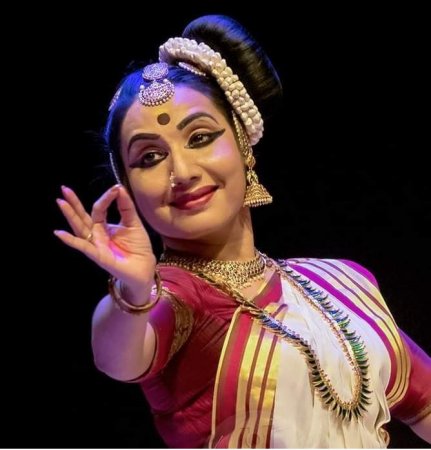 Neena Prasad "We bear up with so many noises in this country. This is our commitment to tolerance and democracy. So, I fail to understand what he was trying to get at?" said Neena over the phone. "Many have spoken up in my favour," she claimed, even the Progressive Movement Wing of the Communist Party, "even though mine is traditionally regarded as a temple art." The judge defended himself saying that the police over-reacted but the police disagreed. "Many lawyers protested too, by binding their mouths with a black cloth", she told me. This apparently worried the District Judge because here were his own fellow officers of the Court standing up against him. In his defence he claimed that he too was a dancer in as much as he had learnt dance until the stage of the arangetram. If already familiar with classical dance, and intimately engaged for so many years, then what did he find so obnoxious about the sur, taal and nritya presentation, one wonders? "But that is not the question I want to ask," said Neena wisely. "I don't want to corner him," she said sagaciously. "And I don't think at all that it is a Hindu-Muslim question, as a few voices are suggesting. I see this as a misuse of power that often comes with delusions of grandeur. In fact," she said, "I don't want to ask him any question. I want to ask the highest authorities of the land only one question; what is the official stand on culture, in this country?" According to her, artistes are the genius minds of the nation that have created the identity of who we are, and how our antiquity continues to be relevant in your times. "If the army protects the nation, we are the ones who make and protect the identity of that nation. Why should we be protected? Protection is for the fragile. We should be celebrated, cheered and strengthened," she argued vociferously. "And we have the freedom of expression that is the greatness of India. Your professional time may be 9-5, but mine is 6pm onwards. If you don't like it, you can stay away but you cannot shut us up," says Neena quite forcefully. "Stand up for us as you stand up for the army. Every one of us in this land is Bharatiya and everyone is Bharat itself." I thought her last words were particularly poignant. Why do some citizens believe that other citizens are lesser? That they deserve to be controlled, to fit into convenient slots, to be thrown away if they don't fit into slots. The last time I checked India was still a democratic country, with all her citizens equal. How then can there be some who can decide what is kosher and what is not? Who can decide whose expression has greater valence, an artist or a District Judge with delusions of grandeur? Manjari Chaturvedi 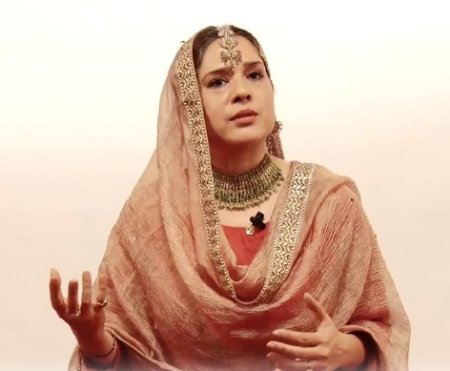 Manjari Chaturvedi Neena Prasad is not alone to have been treated in this manner. Kathak dancer Manjari Chaturvedi suffered a similar ignominy just before the first lockdown. On 16th January 2020, while she was dancing at the invitation of the state government in Lucknow, a carefully curated programme called 'Ishq ke Rang' that drew upon her Sufi Kathak work, and included the iconic qawwali "Aisa banna sawarna tumhe Mubarak", made famous by Nusrat Fateh Ali's rendition. Qawwali is a wonderful example of the ganga jamuni tehzeeb for which Uttar Pradesh is so well known. So she was surprised when she was suddenly and rudely told, "Yahaan Qawwali nahin chalegi". Barely had this been conveyed to her that she saw the compere rush up and start announcing the next programme. While they kept saying that her performance was cut short due to logistic reasons and that there was no cultural, linguistic or religious bias, or the equating of a certain art with a particular religious tradition, one needs to read between the lines. To silence her protestations and the media that picked it up, the officers of the state government even promised to redeem themselves with a subsequent concert, on the occasion of the Uttar Pradesh Statehood Day, in which she could perform the qawwali. The fact of the matter is, as she explained, that it is easier to keep on othering the other rather than embracing him. This is not how citizens and artistes should fall victim to divisive forces. "The space of the arts is sacred and should not be trampled upon. It needs to be left alone as artistic space. Don't polarise it," she argued in a telephonic conversation. Mansiya V.P. 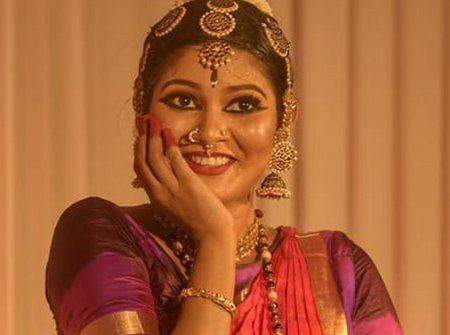 Mansiya If Manjari could feel the stench of othering wafting across, then here is the most recent example of this terrible othering odour. A Muslim Bharatanatyam dancer, with her origins in Kerala, Mansiya V.P, a doctoral research scholar, who is married to a Hindu, was banned from performing in Thrissur's Koodalmanikyam temple, located in Irinjalakuda Municipality. For Mansiya, this was like lightning striking twice. Earlier she had a similar experience at the Guruvayoor temple. The sense of déjà vu has dejected Mansiya who wonders about the secular quotient we subscribe to as a nation. Koodalmanikyam temple and the Guruvayoor temple are two of the five government's Devaswom board, and they find their defence in an age-old practice, and peculiar outmoded belief that a non-Hindu cannot perform inside the temple premises. I say outmoded because it is now 72 years since we adopted our constitution and it is about time for alignment with the constitution of India. We need to get closer to that document by which we all signed up to be citizens of India. Regrettably we are drifting away from it instead. I say peculiar as well for in many temples, especially temples that have performance built as part of its practices, such divisive lines are seldom drawn. Will the arts and artistes of independent India be the next body to be sawed into Hindu and Muslim? A senior Kathak dancer, Prerana Shrimali danced at the Govind ji temple and three of her accompanying musicians were Muslims. "After the show we were all taken to the inner recesses and had darshan and were served prasad with great honour and dignity. So, I can't understand what this is all about," she said, the bewilderment evident in her voice. Another musician, sarod artiste Chandrima Majumdar, wondered why she had been subjected to the ignominy of first having her name announced and then retracted. That is insulting to any artiste. If she had been told earlier she would not have applied to perform at this one, but at some of the others that do encourage dancing, even by non-Hindus. While the brouhaha was on a video emerged of Will Smith, yes, the same win and slap at the Oscars actor, who came in 2018 to Haridwar, he visited Ashrams, had his horoscope cast and even did abhishekh of the Shivaling. Is he more Hindu than Manisya, who has spent her life dancing the glories of the Hindu Gods? It does seem odd. Vinod Panicker 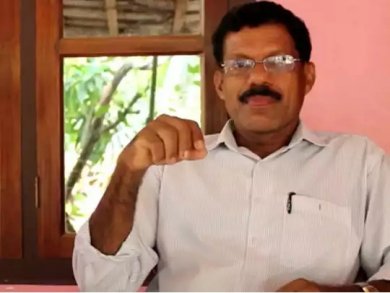 Vinod Panicker This column must include one more story - the story of the Poorakkali dancer who performs as part of the pooram which is a celebration of Vasant. Traditionally the dance ritual Poorakkali is performed by men of the Panicker caste. Vinod Panicker was unceremoniously removed a few days ago from the performance troupe as his son is married to a Muslim woman. Though the son has been married for several years, it is this year that the exclusionary action has taken place. Vinod has also taken a strong position and it is an eyeball-to-eyeball confrontation, in which nothing but a divisionary ideology is winning. The temple committee insists that during the period of the pooram he should stay separately or ask his son and daughter-in-law to leave, so that the committee can with a clear conscience allow him back as then they can admit before Bhagavathy that no non-Hindu lives in his house. Is this not contempt of Bhagavathy since it is very presumptive on their part that the all-powerful Bhagavathy can be so easy to delude? Delusions of grandeur once again on the part of pygmy humans. Tweets, posts and WhatsApp threads Member of Parliament Shashi Tharoor has tweeted in Mansiya's case pleading for the spirit of Vasudhaiva Kutumbakam. But what is to be said about the growing divides between brother and brother, between Ganga and Jamuna and between us and them. The us and them divide is also along caste lines. For long, dancers from devadasi families and kalavanthulu heritage have long bemoaned how their artistic heritage has been usurped by others while the stage has been denied to them. No one can deny the truth of the reform and revival of Bharatanatyam, which included its rechristening, a change in its population of practitioners and a sanitization of its content to suit a certain aesthetic of privilege. This is the truth and often facing up to the truth goes with reconciliation. In most cases, turning the wheel of history is a complex and difficult procedure and reconciliation often doesn't demand more than a recognition of past bearers of cultural wealth. I have heard very few dancers acknowledge the role that the much-maligned devadasi played in keeping intact the nation's cultural wealth. Those who dance Bharatanatyam today owe it to these ancestresses. Not recognizing them is akin to taking from someone and not acknowledging it. In University circles this is called plagiarism, a strong moral problematic. The several days long social media activity has revealed this schism within the community. On one group, independent film maker and visual artist Sunil Shukla, and flautist Chetan Joshi took opposing positions. Joshi argued that Devalayas have idols with pran pratishthan done and so need to be remembered that it is sacred. So, while it is fine that is why even the Khajuraho Dance Festival happens outside the temple. But as far as I recall, even the Maharis who sang as part of the evening sewa did so just outside the sanctum sanctorum. But the case in question is not about dancing in the sanctum sanctorum. He then upped the ante and claimed that it is always Hindus who are asked to compromise their tradition, and finally threw in the gauntlet by wondering if a havan, Hanuman Chalisa could be done in the mosque and since art has no barriers can Bharatanatyam not be done in the mosque? In my opinion the argument is incorrect as the dancer Mansiya is not wanting to do an ayaat from the Quran in the temple. She is wanting to dance, just like all the other dancers, regular items from Bharatanatyam's repertoire. These are items based on the antics and inspiration provided by the Hindu pantheon. Nobody is performing anything conflicting or unmatched. Reacting to the trans barrier argument, Sunil Shukla took the argument that Hindus do not have to go the hard-wired way. It is true that while music is performed in the temple, church, mosque and gurudwara, dance is unique to Hindu temples. Also, Mansiya's desire to dance in temples is proof of the joy that the Hindu way of life encompasses. It's a huge certificate for Hinduism's all-embracing nature! 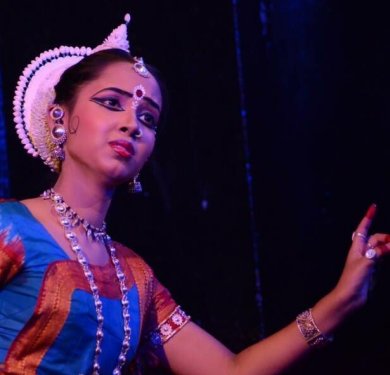 Shimran Zaman A heart touching appeal was made by a young Odissi dancer Shimran Zaman, born to a Muslim family, an alumnus of a convent school, who claimed that she was six when she started dancing. At that age she did not know anything about religion, she admitted. She spent her entire life rejoicing in learning dance and today even though she reads the Quran she also dances the rituals of worship in temples and the deeds of the Hindu Gods and nothing gives her more pleasure than the thought of dancing before the Gods. She then asked innocently the question that had evidently bothered her - As artists, isn't art our religion? It shook me and I hoped that God at least was hearing her. She went on to share the moving story of Salbeg and the darshan of Lord Jagannath, during the Rath Yatra, of how one glimpse would keep Salbeg going through the year, and going by the story of how the Lord stopped his Ratha and kept it unmoving till Salbeg, mobility restricted as he was due to his disability, managed to reach him, suggests that the Lord also needs his true Bhakts. "What message God sends us through his miracles and what message people learn from them, is saddening," she bemoaned. A similar story of how God intervenes was shared by the feminist Kavita Krishnan who remembered that the great Carnatic music scholar and practitioner, Jon B. Higgins, an American musician, scholar and teacher, a disciple of the Balasaraswati family, who won for himself the honorific of Bhagavatar. Much like the issue we are discussing now of a non- Hindu not being allowed entry into the temple, he too was denied entry into the Udupi Shri Krisha Temple. The temple authorities reluctantly let him when he sang an emotional and mellifluous rendering of "Krishna nee begane baro". Amidst all of this, the positions seem to be hardening. The religious identity seems to be strengthening over all others. The artistic identity seems to be pushed back, and the questions that the young dancers are asking are being tossed aside with ageist arrogance and majoritarian muscle. Despite this, there is some sign of hope. For the first time, there is a white anger, and the question is being asked, what value does this nation give to its arts. The Covid period tested the artistes as no one else. All modes of survival were closed to them. Sustenance became a challenge. Yet they kept their hopes up and by their generous artistic sharings they were able to keep our energies up. So how does the nation value them? It was during the Covid time that the "Taking the Temperature" survey was carried out by the Federation of Indian Chambers of Commerce and Industries (FICCI), the British Council and the Art X Company. For the first time it was calculated that the Indian Cultural and Creative sector contributed in 2019, before Covid happened, as much as 2.5% of India's GDP. That is not a small amount. This should prove to the world that we are as much nation builders, apart from identity creators, as the next sector. So, if the artistes are beginning to believe in their self-worth, and if they realise their own value, then their coming together is only a matter of moments. United, they have the courage to say to their detractors, dividers and diminishers - if you were disturbed by the music of a sober classical composition, it appears that you have sensitive hearing, so you should hear us, as we speak. Know that we will accept no limitations on our right to dance. We are all Meerabais and dance we will, anywhere, anytime and of any kind. We know we speak the language of India's soul. If you have forgotten to hear it, as it speaks, as it whispers, as it sings and cajoles, that is your loss. Lament it if you will. But now no more limitations on us. Na jāyate mriyate vā kadāchin nāyaṁ bhūtvā bhavitā vā na bhūyaḥ ajo nityaḥ śhāśhvato 'yaṁ purāṇo na hanyate hanyamāne śharīre These lines from Chapter 2 Verse twenty of the Bhagavad Gita say - The soul is neither born, nor does it ever die; nor having once existed, does it ever cease to be. The soul is without birth, eternal, immortal, and ageless. It is not destroyed when the body is destroyed. Yes, the soul is limitless. So is dance. Remember Shiva danced it in Chidambaram, a city which extends till thought. The soul is neither born nor does it ever die. So, is it, with dance? Self-born Shiva became the dance and the cosmos is still dancing, since then. Nor having once existed, does the soul ever cease to be. The soul is without birth, eternal, immortal, and ageless. That is true of dance too – anadi anant, ageless, immortal, unending! In an unbroken fashion, dance has been danced on this earth of ours since prehistoric times. The soul is not destroyed when the body is destroyed. Neither is dance. That is why generation after generation even after being violated for dancing, still dance, transferring the urge from body to body, generation to generation, era to era. Such is the dance and the dancer, who have in them both the skills of Shiva and Parvati. So, despite many dancers still taking an exclusionary position, I see that never before have so many come out to take on an inclusive stand. The inclusivists see themselves as dancers, not Hindus, or Muslims, or Christians or Buddhist, not Parsees, not Jains nor Sikhs. It is as if they are saying, "We are dancers. Dance is our only religion. We will dance for all the Gods, yours and mine, making them all, ours. We will dance for all of nature, the earth, sky, water, and air. We dance in thanksgiving; we dance in atonement, we dance to celebrate this multi coloured world. We dance to embrace all beings and forms. No longer do we wish to be restricted by any boundaries, nor bamboozled into small categories. We are viraatroopi, one with the dance in the cosmos. Despite our anger at this poor treatment we have encountered, we dance a mangalam, a shanti shloka, a mukti mangal vachana, a Vandana and a blessing for you as well. We will not talk to power any more. We will now dance to power, everywhere and anywhere." Is that how you see yourself? I ask for this deep but essential contemplation from the reader and all dancers. It is time for you to think if it is alright for you to dance in those places where others of your ilk cannot. What is it that you can do to reclaim dance spaces for dance? Once you lose one space and don't reclaim it soon, you will lose many other spaces. Write your own cartography and write your own script. Weaponize your dance to serve its own interests! It's time to be Meera Bais of the twenty-first century and dance because you must!.  Dr. Arshiya Sethi, trained in Kathak, has served as dance critic, commentator, institution builder for the arts, having created both tangible and intangible institutions and equities. She has been a Fulbright Arts Fellow (2003-2004) and a post doctoral Fulbright (2016-2017). Her doctoral work has been on the link between politics and dance in the case of Sattriya. She is presently working on the intersection of dance and activism / social justice through her NGO, Kri Foundation (estd. 2003), and has extended her academic work to Indian dance in the diaspora. Post your comments Please provide your name and email id when you use the Anonymous profile in the blog to post a comment. All appropriate comments posted with name & email id in the blog will also be featured in the site. |